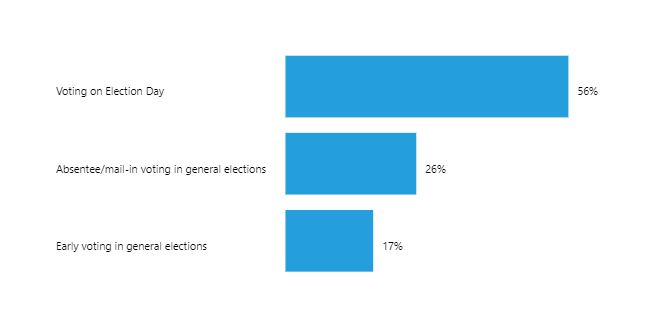Health
How COVID-19 is changing primary voting—and the November election

In October, the US recorded 1.86 million new cases of COVID-19, 2.4% below the monthly high of 1.9 million in July.
In July, counties with higher population densities reported higher case rates; in October, less dense counties had the highest case rates. Counties with more than 1,000 residents per square mile — home to 35.1% of the population — had an average case rate of 610 cases per 100,000 people during July. The average monthly case rate in these areas in October was 445 cases per 100,000 people, down 27.1% from July.
In counties where the population density is less than 125 people per square mile — home to about 21.7% of the population — the case rate increased 47.7% from an average of 525 cases per 100,000 in July to 775 cases per 100,000 in October.
As a result, some of the least dense states continued to lead the nation in new cases reported. North Dakota and South Dakota, which led the nation in case rates in September, also led in October. The case rates in those states more than doubled. North Dakota’s cases increased from 1,316 per 100,000 in September to 2,896 per 100,000 in October. South Dakota’s increased from 1,004 to 2,668 per 100,000.
Only four states reported fewer new cases in October than in September: Hawaii, Louisiana, Georgia, and South Carolina.
There were 23,090 coronavirus-related deaths in October, slightly higher than the 23,031 in September. Five states accounted for 32.7% of October deaths: Florida, Texas, California, Illinois, and Georgia. Wisconsin had the highest increase in monthly deaths, with 705 COVID-19 deaths in October compared with 205 in September.
Coronavirus-related hospitalization rates hit a pandemic low of 3.9 per 100,000 Americans during the week of September 19, according to estimates from the Centers for Disease Control and Prevention. While October's hospitalization rates are preliminary, the rate ticked up at least 38% to 5.4 hospitalizations per 100,000 people by the week of October 17. The 65+ population had a 48.5% spike in hospitalization rate during this period from 10.1 hospitalizations per 100,000 to 15.
On July 29, 9.9% of all hospital beds were filled with COVID-19 patients, according to Department of Health and Human Services data. Since then, the share dropped to as low as 4.6% on October 3, before increasing to 7.4% on November 2.
The latest state-level data from the Bureau of Labor Statistics shows that 12.3 million fewer people were employed in September than in February. No state has fully regained the jobs lost during the pandemic.
With 7,174,631 known cases at the end of September, there were 1.7 fewer jobs for every known COVID-19 case in the US compared to February employment levels. States with lower case counts compared with other states tend to have the highest ratio of jobs lost. In Vermont, where there have been 1,752 known cases through September, there were also 23,800 fewer jobs. That’s 13.6 jobs lost per case. In Hawaii, which had a 12,410 cumulative case count at the end of September, it still had 131,000 fewer jobs than in February. That’s 10.6 jobs lost per case.
On the other end, Mississippi had 98,189 cases as of September 30. It also had 3,800 fewer jobs than in February. That’s one job lost for every 25 cases.
Across the country, nearly three-fourths of all businesses report a large or moderate effect on their business due to the COVID-19 pandemic, based on the US Census Bureau’s latest Small Business Pulse Survey. Businesses in Hawaii and Alaska report being most impacted by the virus, with over 40% of small businesses reporting a large negative impact from COVID-19 and over 80% of small business owners reporting a large or moderate impact on their business. In contrast, less than 20% of small businesses in Idaho and Delaware report a large negative effect from coronavirus.
Small businesses surveyed said they were setting expectations for a long and slow recovery. In the October 20 Small Business Pulse survey, 45% of businesses expected it to take over six months for business operations to return to their pre-pandemic level, and 7.3% reported never expecting their business operations to return to normal. Only 4.4% of small businesses expect their businesses to return to normal in three or fewer months. Some small businesses have escaped the pandemic without major harm, though, with 28.5% reporting a full recovery or no impact on their normal operations level. These figures have not changed from the September 26 survey.
State tax revenue declined steeply in the second quarter due to the economic fallout of the COVID-19 pandemic. Many states enacted policies that forced businesses to close, plus many Americans lost jobs and incomes fell, thereby reducing sales tax collections. Many states followed the federal government's policy and extended their spring income tax filing deadline until July, thereby pushing large portions of tax collections into the third quarter of 2020—a new fiscal year for most states.
Comparing the second quarter of 2020 to the second quarter of 2019 highlights a massive decline in state government tax collections of 29%, with two states, Alaska and Connecticut, seeing state tax collections cut in half for the second quarter. Only Idaho, Maine, and South Dakota increased collections from the second quarter 2019 to the second quarter 2020.
If this decline in tax revenue continues through 2020, state governments may have to make difficult choices in balancing their budgets, potentially cutting programs or workforce. At the current time, however, state governments have lost fewer jobs than the economy overall — there are 4% fewer jobs in state government compared to August of last year, compared to 7% fewer jobs for the economy overall.
Newsletter
Keep up with the latest data and most popular content.